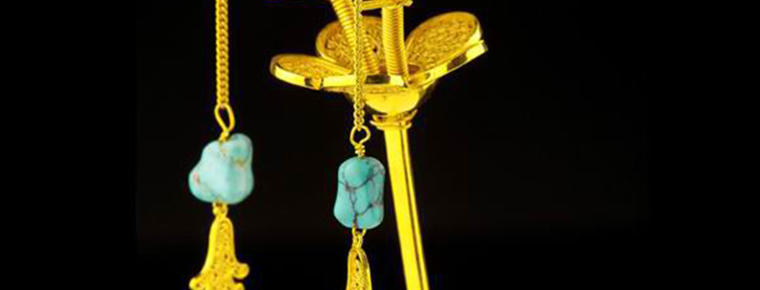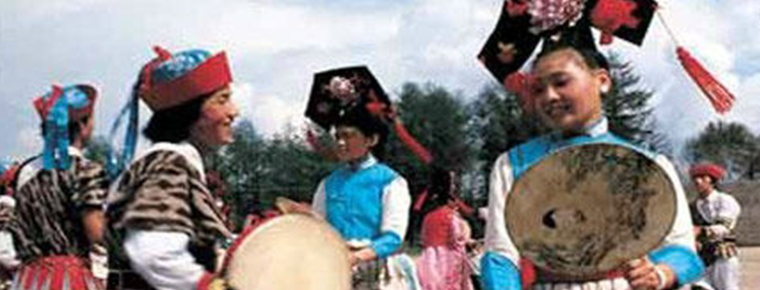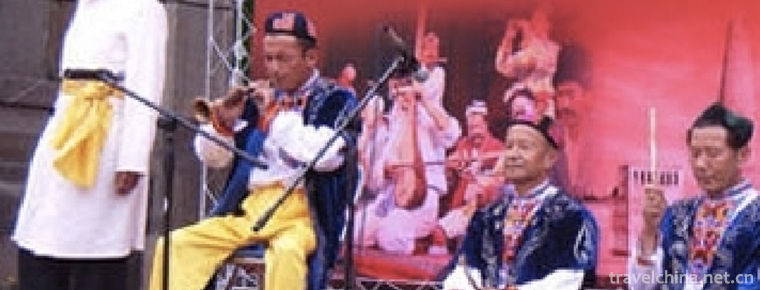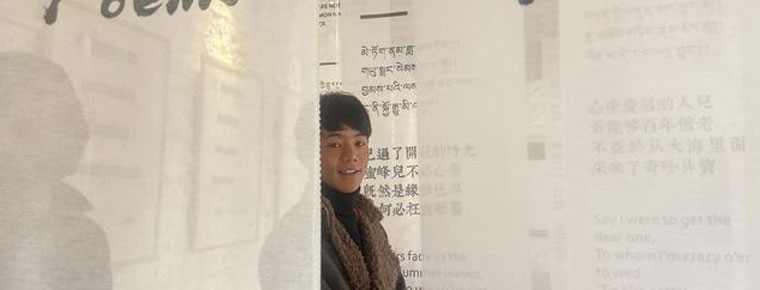Yi Peoples Cigarette Box Dance
Yi Peoples Cigarette Box Dance
Yi cigarette box dance, the traditional dance of Hani Yi Autonomous Prefecture in Honghe, Yunnan Province, is one of the national intangible cultural heritage.
Cigarette box dance is a dance with "cigarette box" as props. The so-called "cigarette box" is a round box made of bamboo and wood to hold tobacco. When dancing, they hold their upper and lower lobes in their hands and use their fingers to play regularly. It is not only a part of the dance, but also a accompaniment of the dance with its pleasant and strong rhythm sound. Because the "four strings" must be used as the main accompaniment instrument when dancing, it was called "chord dancing" by the people in the past. Because the cigarette box has become an important prop in "chord dancing" and made "chord dancing" rich in unique artistic personality, people generally call chord dancing "cigarette box dancing".
On May 20, 2006, the Yi people's cigarette box dance was approved by the State Council of the People's Republic of China and listed in the first batch of national intangible cultural heritage list, heritage number: III-37.
historical origin
The early cigarette box dance, which originated in the primitive society of the Yi people and attached to the primitive religion, was an important part of the activities of wedding, funeral, religious sacrifices and so on.
In the early Yuan Dynasty, the vast area along the Red River was a closed or semi-closed farming society, which was relatively backward in political, economic and cultural aspects. Yi culture is a strong local culture. The culture of the Han people living here is gradually integrated into the Yi culture.
By the Ming Dynasty, the new farming technology brought by a large number of Han troops and businessmen who migrated to Honghe area greatly promoted the rapid development of Yi people's productivity. Yi and Han cultures interact and blend with each other. A large number of Han cultures are absorbed and integrated by the Yi people. This should also be the time when cigarette box dances form a rough outline. It was found that cigarette boxes with finger flicks can produce crisp sounds, which can be used to unify the rhythm and increase the dance atmosphere, so cigarette boxes were integrated into the dance and eventually formed a cigarette box dance.
After the fifteen years of Hongwu in the Ming Dynasty (1382), with a large number of Han people pouring in and the wide spread of Han culture, the Yi classical culture was strongly impacted. Under this historical background, after a short period of pain, the Yi people absorb foreign culture with an open mind, improve themselves tenaciously and forge a new culture. After the baptism of foreign culture, cigarette box dance, through continuous absorption, digestion and integration, leaps out of the "trinity" framework and becomes an independent dance art, with a fairly stable dance system, personalized performance and music form.
In the early 1950s, the Yi people's cigarette box dance was put on the stage, that is, it was loved by the people and literary workers both inside and outside Honghe Prefecture and Yunnan Province. In 1953, at the first national folk music and dance concert, Jianshui and Shiping folk artists, as Yunnan delegates, took cigarette box dancing to the stage of Huairen Hall in Beijing to perform. They were met by Premier Zhou Enlai and Marshal He Long.
During the Cultural Revolution, the government called for breaking the four old customs. At that time, the custom of dancing in cigarette boxes and eating tobacco was considered immoral, which required that no place should be carried out. Dancing cigarette box has become a secret activity, and "eating tobacco" is basically prohibited. The inheritance and development of cigarette box dance has been greatly damaged.
In the early period of reform and opening up, cigarette box dancing was recognized by the people and supported by the government. No matter where it was, the sound of cigarette box dancing could be heard. During this period, cigarette box dancing changed from male-female pair dancing to homosexual group dancing, and became an important entertainment for people in Jianshui, Shiping and other places. At this time, the function of cigarette box dancing has changed. Cigarette box dancing will appear in the production of labor, New Year's Day, marriage and funeral, building a house and lifting a beam, and mainly in the funeral occasions to dance cigarette box dancing.
Two years after the reform and opening up, cigarette box dancing is at its peak. Every family in Jianshui, Shiping and other places must invite people to dance cigarette box dancing when building houses and celebrating New Year's Day. In the absence of festivals, people will gather to dance cigarette box dancing. People also raise funds to organize cigarette box dancing performance teams to exchange cigarette box dancing activities between villages or villages. It is in this environment that children are immersed in and formed a natural heritage. For example, the two cigarette box dances of "Dou Hou Hu" and "Old Man" were spread to some schools in Kunming area, and became an important part of cultural and sports activities. It is not difficult to understand that the cigarette box dance at that time occupies an important position in the local social and cultural activities, which comprehensively reflects people's feelings, personality, spirit and culture in life.
Dance features
Types of performances
The types of performance of cigarette box dance include pure dance, performance, skill and song and dance. Pure dance cigarette box dance refers to pure dance action combination, such as three strings, two and a half steps, shoe shell, Saigudu, triangular Heinimo, brother Amiejia kneeling contract, driving thin horses, looking for each partner, etc. Its action combination is full of rhythmic beauty.
Performing cigarette box dancing is a kind of program with characters and plots, reflecting life interest, rich movements, high difficulty skills and strong appreciation, such as monkey wrenching, cock fighting, duck fishing, mute firewood, Mason stoning, hawk tapping chicken, pigeon eating, etc. These program titles are not only the content of the program, but also the form of the program. The performers vividly imitate the shapes, dynamics and manners of different animals, fully demonstrating the wisdom of the Yi people in observing and expressing their lives.
Skills of cigarette box dancing are mostly based on imitating and expressing animal's posture and dynamics, such as long insects twisting waist, pouring water into jade bottles, ants carrying salt, swallows resting beams, fairy bridging, calf ploughing, inverted golden hook, shelf music and so on. The completion of these movements requires good physical conditions, flexibility, strength and control. These abilities are not a day's work, and require special long-term training to achieve.
The cigarette box dance of singing and dancing is a traditional form with simple movements and few difficult skills. It mainly takes changing formation as its form of expression. The basic dance formation includes six-piercing flowers, Dali string, Dahongsi line, a nest of sparrows in Xixiangba, etc.
Performing action
The gestures of the Yi people's cigarette box dancing are mainly manifested in carrying burdens, using hoes, sickles, axes to work, using skimmers and sticks to peel off and process grain, and then refined, processed and abstractly transformed. Therefore, it is not only beautiful in image, but also has a strong flavor of national life. Hand position can be divided into low position, horizontal position, high position, lateral position and posterior position.
There are many movements on the feet of Yi people's cigarette box dancing, which is another major feature of Yi people's cigarette box dancing. The Basic Footwork includes: foot closure, hall crossing, small pedal, swing running, jump running, foot fighting, water-lifting step, step on the hall, leg-covering back pad and right leg-covering step. All of them are extracted from the actions of Yi people's life, production and labor, and are artistically processed.
Performing Instruments
In the performance of cigarette box dance, the four strings as the main instrument of cigarette box dance, play a variety of skills. Pushing, pulling, singing and kneading with the left hand give the four strings a rich expressive force with distinctive striking and sliding tones; besides playing, picking and playing with the right hand, it also sweeps the inside and outside strings to produce a harmonious and pleasant sound; while performing, skilled folk artists tap on the surface of the board and produce a sound similar to that of cigarette boxes. The effect is to make the melody more elegant and wild.
Inheritance and Protection
Inheritance value
As a characteristic dance of the Yi people in southern Yunnan, the cigarette box dance shows the Yi people's historical outlook, moral outlook, values and thinking mode with its unique dance vocabulary. It has high research value in the fields of ethnology, folklore and sociology. Through skillful use of head, foot, body, hand, waist and other body parts, cigarette box dancing vividly expresses the unique aesthetic interest of the Yi people with beautiful dancing posture, and at the same time, high-difficulty dancing skills such as rolling down waist in series also have high artistic value.
Cigarette box dance is popular with the masses because of its unique artistry and ornamentality. Strengthening the protection of cigarette box dancing will play a positive role in enriching the cultural life of the masses, promoting the construction of spiritual civilization, promoting national unity and building a harmonious society. At the same time, with the development of cultural industry, with the construction of national cultural province and national cultural prefecture, we should actively study the development and utilization of cigarette box dance, so as to make it have its due economic value.
Current situation of inheritance
With the changes of the times, the humanistic environment of cigarette box dancing has changed dramatically. The traditional custom of "eating tobacco" has disappeared. The style of cigarette box dancing has become simplified and its connotation has become superficial. The traditional classical cigarette box dancing routine with full charm is on the verge of being lost and needs urgent rescue.
Heritage figures
Shi Wanheng, male, Yi nationality, born in Honghe, Yunnan in 1947. The second batch of national intangible cultural heritage projects, the representative inheritors of Yi's cigarette box dance, was declared by Honghe Hani Yi Autonomous Prefecture, Yunnan Province.
protective measures
Shiping county government held "tofu festival", "citrus festival", "bayberry festival" and "lotus festival", which displayed and promoted the development of cigarette box dance in varying degrees.
In October 1996, Longpeng Yi people's cigarette box dance was invited to Beijing to attend the opening ceremony of the 6th National Sports and Dance Championship. Later, Longpeng Town was named "The Town of Chinese Art". The Ministry of Culture named Longpeng Town as "the hometown of Yi people's singing and dancing" and "the hometown of cigarette box dancing".
Mr. Wu Zhigang, former chairman of the Literary Union of Shiping County, wrote the book "Yi People's Cigarette Box Dance and Seafood Tune", describing the excavation and development of the cigarette box dance; Ms. Feng Xu, assistant of Shiping County Chronicle Office, compiled 95 photographs and 99 discs to record the performance of the cigarette box dance.
In 2006, after the second cultural census, Shiping was declared as "the national intangible intangible cultural heritage", and Shiping was also named "the hometown of cigarette box dance in Shiping County".
social influence
Important performances
During the Mid-Autumn Festival in 2018, cigarette box dancing was displayed in the newly launched immersion panoramic theme show of Splendid China, the original ecological non-heritage exhibition.
April 7, 2019, "March 3, Stepping Song and Dancing" - Yunnan Yi people's cigarette box dance "Cigarette Box Huqin Tune" was displayed in the exhibition of the representative project of intangible cultural heritage of traditional music and dance in southwestern provinces and autonomous regions, which was carried out happily by Guangxi Museum of Nationalities.
Honorary recognition
In 1998, the Campus Cigarette Box Dance of Baxin Primary School participated in the "National Primary and Secondary School Literature and Art Festival" Video Competition organized by the Ministry of Education, the Ministry of Culture, the State Administration of Radio and Television and the Central Committee of the Youth League. It won the second prize and the first prize in the competition of Yunnan Province.
In August 2015, in the 10th National Games, the Yi people's cigarette box dance won the first prize on behalf of Yunnan Province in the skills competition of performance items.


-
nanling national forest park
Nanling National Forest Park is the largest nature reserve in Guangdong Province and a treasure house of rare animals and plants. The park is located in the core of Nanling Mountains.
Views: 139 Time 2018-12-31 -
Chengshantou Scenic Spot
Chengshantou Scenic Spot is located at the easternmost end of Chengshan Mountains in Rongcheng City, Shandong Province, so it is named Chengshantou. Chengshantou is 200 meters above sea level.
Views: 187 Time 2019-01-05 -
Suzhou suburb mudu town
Mudu Ancient Town, nicknamed Duchuan, Xujiang and Xiangxi, is located in the southeast of Jiangsu Province and the west of Suzhou Ancient City. Located in the Taihu Lake Basin.
Views: 136 Time 2019-02-07 -
Making Skills of Filament Mosaic
Silk mosaic is one of the traditional handicraft techniques in China. Gold, silver and copper are drawn into silk, and various decorations such as jewelry and utensils are made by various techniques..
Views: 138 Time 2019-05-04 -
Manchu speaking Department
Manchu Folk Talk Department refers to a long prose narrative literature created and preached by Manchu folk artists, which aims to reflect the war life and emotional world of the Manchu people in hist.
Views: 125 Time 2019-05-19 -
a type of Shaanxi Opera popular in the Weinan Dali region
Bowl-bowl tune is one of the local operas in Shaanxi Province, also known as "lamp-bowl tune" and "Ruan'er tune". The former is named for the main rhythm of the small copper bowl a.
Views: 432 Time 2019-06-25 -
Uygur Drum Music
Uygur drumming music is a kind of national instrumental music widely circulated in the Uygur communities in the north and south of Tianshan Mountains, Xinjiang. Uygur drum music is an important kind o.
Views: 528 Time 2019-06-26 -
Longmenshan earthquake site park
This entry is lack of information column, supplement the relevant content to make the entry more complete, but also can quickly upgrade, come on! The site earthquake park includes the widely spread ruins of Xiaoyudong bridge.
Views: 179 Time 2020-11-05 -
The announcer Ding Zhen will not be on duty until half a year later
On December 6, just after yesterday's live media broadcast, Ding Zhen met with more than 20 fans from all over the country to take photos at noon. Ding Zhen is no longer as shy and helpless as he was when he first met a stranger. After half a month's popularity,.
Views: 114 Time 2020-12-06 -
Location of Meishan
Meishan is located in the southwest of Chengdu Plain and the middle reaches of Minjiang River in Sichuan Basin. It spans 29 ° 24 ′ - 30 ° 16 ′ N and 102 ° 49 ′ - 104 ° 30 ′ e. it is 150 km long from east to west and 72 km wide from south to north. It connects Chengdu,.
Views: 354 Time 2020-12-18 -
Cultural undertakings in Guangan
As of 2019, there are 5 radio and TV stations and 2 Radio and TV stations in Guang'an City. The comprehensive coverage rate of broadcasting is 99.7%, and that of television is 99.8%. There are 7 public libraries, 21 theatres and theatres, 4 museums an.
Views: 330 Time 2020-12-19








